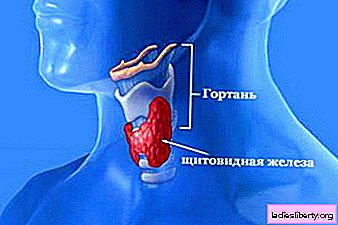
Goiter (second name struma) - a group of diseases associated with focal neoplasms in the thyroid gland. The manifestation of the negative consequences of the disease largely depends on the hormonal background, rather than on the location and size of the nodular neoplasm.
Modern medicine distinguishes the following morphological forms of goiter: nodular colloid goiter, malignant tumors in the thyroid gland, as well as follicular adenomas. In addition, goiter is classified according to its location: ordinary, annular, sternal, dystopic (goiter of the root of the tongue or additional thyroid gland).
Goiter - the causes of the disease
Science has not yet established the exact causes of goiter. It is known that a significant role in the formation of the disease is played by a genetic predisposition, as well as a lack of iodine in the body. However, it is believed that goiter occurs due to the combined effect of several negative factors at once. These include the following:
- energy deficiency (hereditary or acquired);
- a variety of diseases of the internal organs;
- adverse environment.
Goiter - symptoms of the disease
As a rule, formations related to the thyroid gland are small and insignificant. A person may not notice their presence.
Additionally, the following symptoms of goiter can be diagnosed:
- a feeling of sore throat or fullness of the throat;
- difficulty breathing and swallowing;
- rapid heart rate and heartbeat;
- sweating and weight loss;
- state of depression, fatigue;
- nervousness.
Goiter - diagnosis of the disease
The primary diagnosis of goiter is palpation of the gland. When a neoplasm is detected, an ultrasound is prescribed to determine the exact size of the formation and volume of the thyroid gland.
In the event that, on palpation and ultrasound, a formation with a diameter of 1 cm or more is detected, a fine-needle aspiration biopsy is prescribed. With a smaller node size, this procedure is performed only if a malignant tumor is suspected. The combination of ultrasound and biopsy can significantly increase the information content of studies.
If the goiter is too large and located posteriorly, then there is a danger of its displacement and compression of the airways. In such a situation, an x-ray of the chest and esophagus is prescribed with contrasted barium. For a more detailed diagnosis of sternal goiter, they sometimes resort to magnetic resonance imaging.
Goiter - treatment and prevention
In most cases, goiter does not require medical or surgical intervention, since the disease has no pathological significance for the body. It is enough for such patients to control the course of the disease and undergo ultrasound and general thyroid examination once a year.
In case of large goiter sizes, which lead to compression syndrome or changes in appearance, it is necessary to reduce the functional load on the thyroid gland. Such treatment will allow the gland to work in a normal mode, while not including additional reserves that lead to the occurrence of neoplasms. Treatment comes down to either taking hormonal drugs or eliminating the influence of factors pathogenic to the body.
Malignant tumors are diagnosed in 5 percent of cases. In this situation, treatment may consist in removing the tumor surgically or in the use of conservative drug therapy. It is worth noting that surgical intervention does not eliminate the causes of goiter, therefore it is important to reduce the influence of pathogenic factors leading to the onset of the disease.
Goiter prophylaxis usually boils down to increasing the proportion of iodized foods in the diet.
Comments











